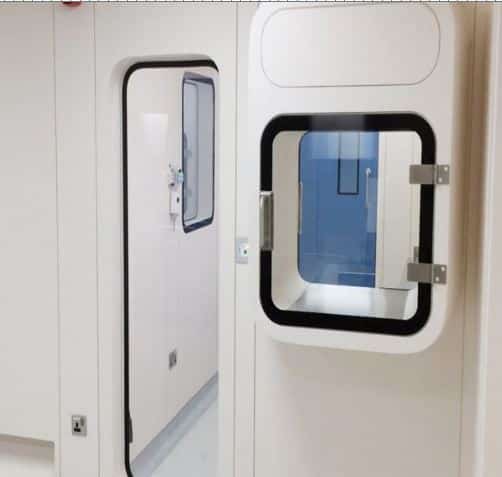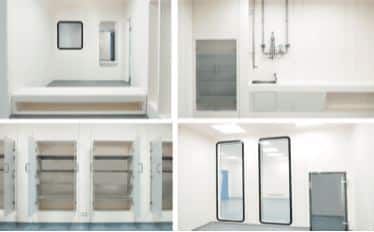Turnkey Cleanrooms: End-to-End Validation in Healthcare Environments
introduction
Delivering turnkey cleanroom projects with comprehensive end‑to‑end validation ensures that healthcare facilities achieve compliance, functionality, and rapid deployment without compromise. By leveraging modular cleanroom construction—integrating prefabricated clean room panels, HEPA filtration, and validated cleanroom systems—organizations minimize on‑site disruptions, accelerate time‑to‑operation, and shift validation risk to a single accountable partner. This article provides a dive into each validation stage (DQ, IQ, OQ, PQ), best practices, and continuous monitoring strategies for hospital cleanroom environments, and concludes with how Ultravision’s “mrc cleanrooms” offerings support your medical projects and healthcare solutions in the UAE and Dubai.

Importance of Turnkey cleanrooms in Healthcare Projects
Cleanrooms are controlled environments where airborne particulates and microbes are strictly regulated. In healthcare, hospital cleanroom spaces—such as ISO 7 compounding pharmacies and ISO 5 aseptic filling suites—protect patient safety and product integrity during critical processes. Ensuring these spaces perform reliably requires validated cleanroom systems that combine HVAC design, material finishes, and robust monitoring.
Benefits of Turnkey cleanroom systems
Single‑Point Accountability
With a turnkey model, one vendor handles design, fabrication, installation, qualification, and hand‑over. This single‑point accountability reduces coordination issues and finger‑pointing among multiple contractors.
Faster Deployment with Modular cleanroom Solutions
Modular construction uses clean room panels and HEPA fan filter units (FFUs) prefabricated off‑site. According to American Cleanrooms, “the installation of a modular turnkey cleanroom can take less than one‑third of the time as conventional construction”. This accelerates time‑to‑operation and minimizes disruption.
Cost Predictability and Quality
Fixed‑price turnkey contracts and ISO‑certified factory fabrication ensure budgets stay on track and quality is consistent across all cleanroom systems components .
Cleanroom Project Lifecycle and Validation Stages
Design Qualification (DQ) for clean room panels and systems
Objective: Confirm that the proposed design meets User Requirement Specifications (URS) and applicable standards (ISO 14644‑1, EU GMP Annex 1, FDA 21 CFR Part 11).
- URS Development: Define ISO class (e.g., ISO 5, ISO 7), temperature (20 ± 3 °C), humidity (45–55 %), and critical utilities.
- Functional Design Specification (FDS): Detail layouts, panel types (GRP, HPL), FFU capacities, door interlocks, and BMS interfaces.
- Risk Assessment: Identify contamination sources, leveraging clean room panels like GRP for joint‑free surfaces and chemical resistance .
Installation Qualification (IQ) of mrc cleanrooms
Objective: Verify that equipment and components are installed per design and manufacturer specs.
- Panel & FFU Inspection: Check dimensions, joint seals, and filter installation against MRC factory certificates from the brochure.
- Documentation: Record batch numbers for mrc cleanroom panels, HEPA filters, and hardware; collect as‑built drawings and calibration certificates .

Operational Qualification (OQ) for mrc cleanrooms
Objective: Demonstrate functional performance under simulated conditions.
- Airflow Mapping: Validate unidirectional flow (0.36–0.54 m/s for ISO 5) using calibrated anemometers at HEPA outlets .
- Pressure Differential Testing: Ensure inter‑area differentials (e.g., +15 Pa from ISO 7 ante‑room to ISO 5 filling area) are maintained.
- Environmental Monitoring: Conduct particle counts (≤ 352,000 particles/m³ ≥ 0.5 µm for ISO 7) and temperature/humidity checks.
- BMS & Alarm Verification: Test alarm setpoints and interlock sequences for door locks and FFU failure warnings.
Performance Qualification (PQ) in cleanroom systems
Objective: Prove consistent performance during actual operations with staff and equipment.
- Dynamic Particle Sampling: Perform active particle counts at critical zones during representative workflows to confirm continued compliance with the specified ISO class.
- Microbiological Monitoring: Employ both passive (settle plates) and active (air samplers) methods to verify that viable contamination remains within the acceptable limits defined in your facility’s protocols and applicable regulatory guidance.
- Cleaning & Disinfection Validation: Test the effectiveness of your standard cleaning procedures—such as hydrogen peroxide vapor or other approved disinfectants—on panel and furniture surfaces, ensuring they support the ongoing microbial control strategy.
Re‑Qualification & Continuous Monitoring
Objective: Sustain validated state through periodic checks and data-driven trend analysis.
- Annual Re‑Qualification: Repeat OQ and PQ protocols, especially after modifications (e.g., adding pass‑throughs or changing finishes).
- Trend Analysis: Leverage BMS logs and continuous particle counters to detect deviations early.
- Change Control: Formal impact assessments, updated risk logs, and re‑validation as part of quality management.
Best Practices in Cleanroom Validation
- Early Cross‑Functional Engagement: Include pharmacists, microbiologists, and maintenance teams during DQ to capture all operational requirements .
- Third‑Party Certification & FAT: Use accredited labs for Factory Acceptance Testing of FFUs and ISO certification of the complete cleanroom system .
- Digital Validation Master Plan (VMP): Implement an electronic VMP for real‑time access to protocols, deviations, and certificates—streamlining audits.
- Modular Prefabrication: Off‑site assembly of modular cleanroom units ensures controlled manufacturing conditions and reduces on‑site contamination.
Frequently Asked Questions
What distinguishes IQ, OQ, and PQ?
IQ verifies installation accuracy; OQ tests operational parameters; PQ confirms performance under real‑world conditions.
How often must hospital cleanrooms be re‑qualified?
At least annually, and after any significant process or layout changes.
Which standards govern cleanroom validation?
ISO 14644‑1/2, EU GMP Annex 1, FDA 21 CFR Parts 210/211, and WHO EVS guidelines.
Can modular cleanrooms achieve ISO 5 classification?
Yes—when properly designed with validated HEPA filtration and clean room panels like GRP.
What is the benefit of turnkey over stick‑built construction?
Turnkey delivers faster deployment, cost predictability, quality control, and single‑point accountability.
How is pressure differential validated?
Using calibrated differential pressure transmitters and digital BMS logs.
Are GRP panels compatible with chemical decontamination?
Yes—MRC’s GRP panels resist hydrogen peroxide vapor and peracetic acid (per brochure specs).
What role does digital VMP play?
It centralizes validation records, expedites audits, and ensures electronic traceability.
How do you validate cleaning procedures?
By conducting post‑cleaning surface and air sampling, verifying reduction per pharmacopeial standards.
What defines successful PQ?
Consistently meeting particle and viable count limits during routine, multi‑day operations.
Ultravision Medical Projects with mrc cleanrooms
Why Ultravision Excels in Medical Projects
Ultravision Medical Equipments delivers turnkey medical projects featuring mrc cleanrooms, handling everything from design and supply of cleanroom systems to installation, qualification, and ongoing support. As leading medical equipment suppliers in UAE and medical equipment suppliers in Dubai, our portfolio spans cleanroom build‑outs, ultrasound machines, and preventive medical equipment repair.
Comprehensive Healthcare Solutions
- Design & Engineering: Custom hospital cleanroom layouts using GRP clean room panels, integrated HEPA FFUs, and BMS interfaces, per the MRC brochure.
- Installation & Qualification: End‑to‑end IQ/OQ/PQ execution, backed by third‑party certifications, to meet ISO 14644, GMP, and FDA standards.
- After‑Sales Support: Preventive maintenance contracts, staff training, SOP development, and 24/7 technical assistance for continuous compliance.
Our Capabilities
- Medical Projects: Complete project management for sterile compounding suites, operating theatres, and IV‑lab cleanrooms.
- Healthcare Solutions: Turnkey cleanroom systems, HVAC integration, and BMS customization.
- Equipment Supply & Repair: Full range of ultrasound machines, diagnostic imaging, and cleanroom hardware serviced by factory‑trained technicians.
By partnering with Ultravision and specifying mrc cleanrooms, healthcare providers secure a fully validated, turnkey modular cleanroom solution that meets the highest industry standards, accelerates time‑to‑operation, and ensures patient‑safe environments.

